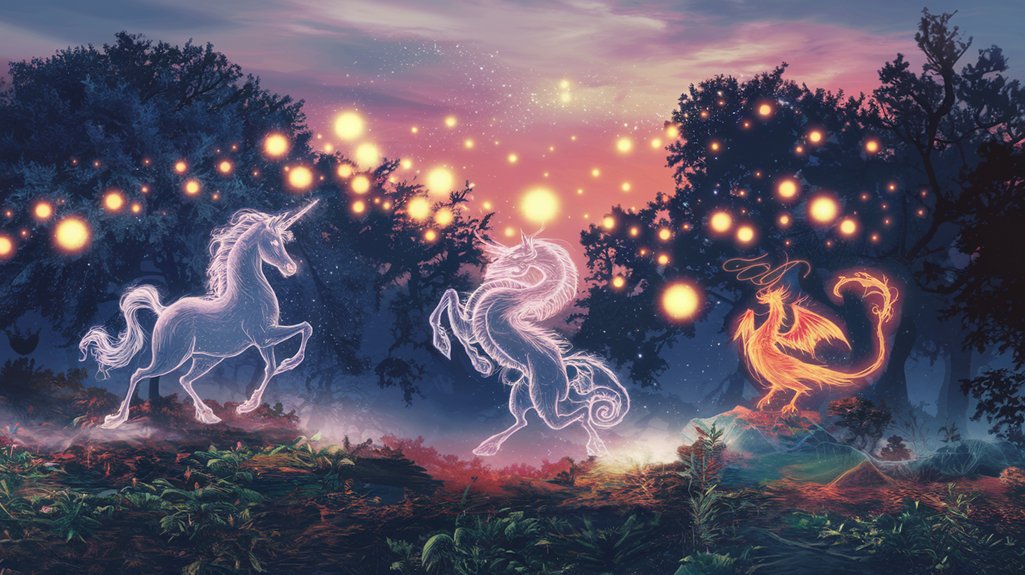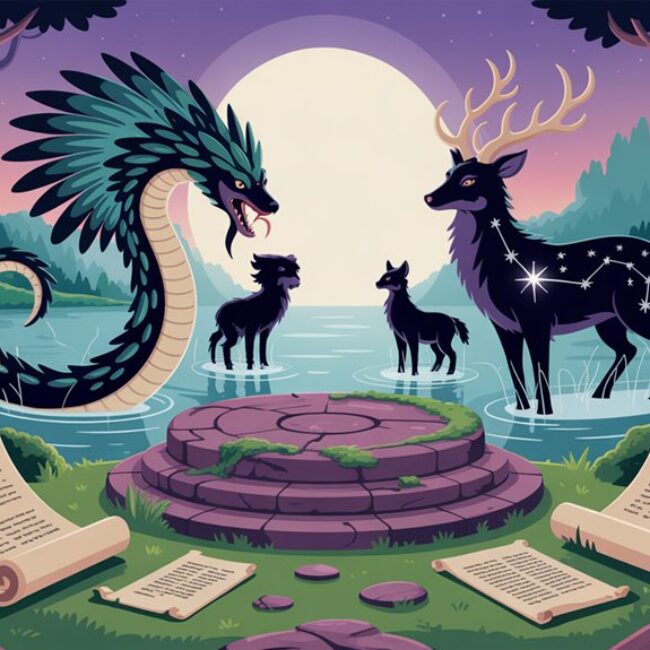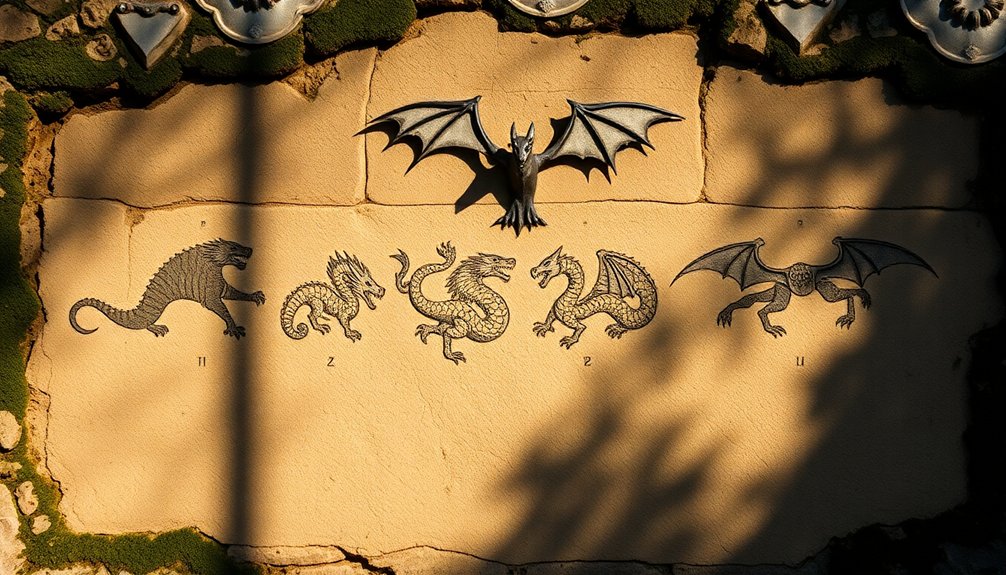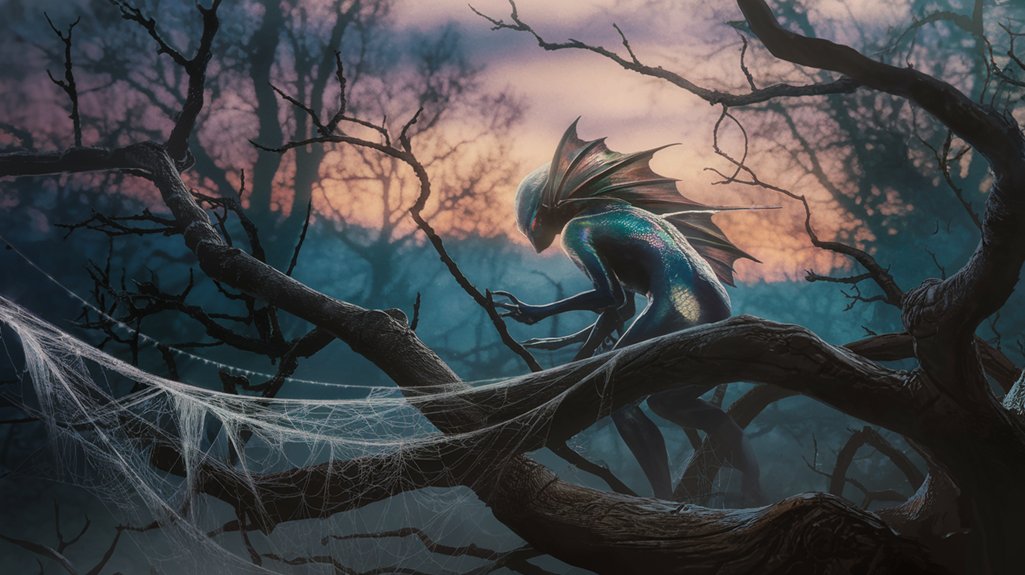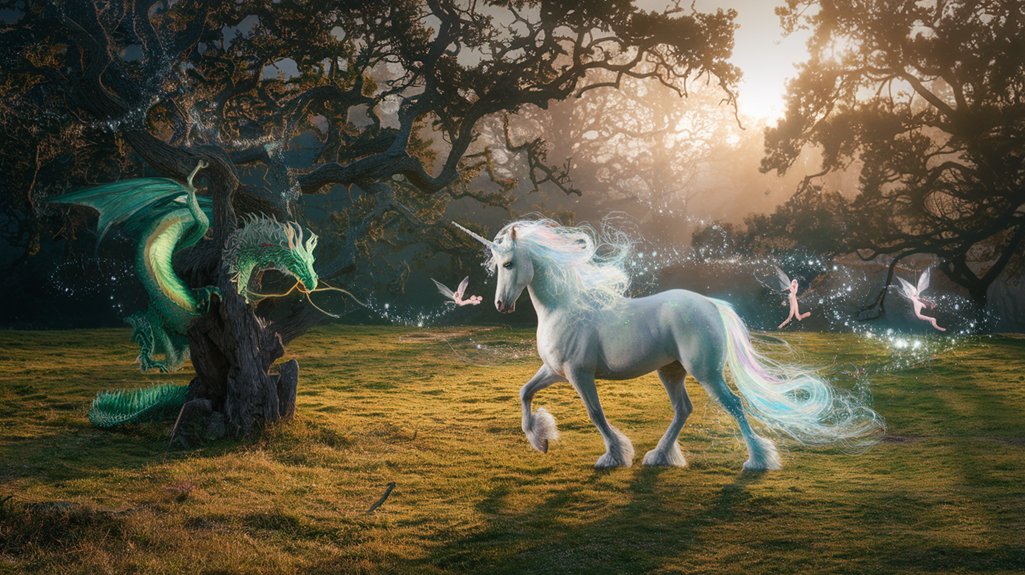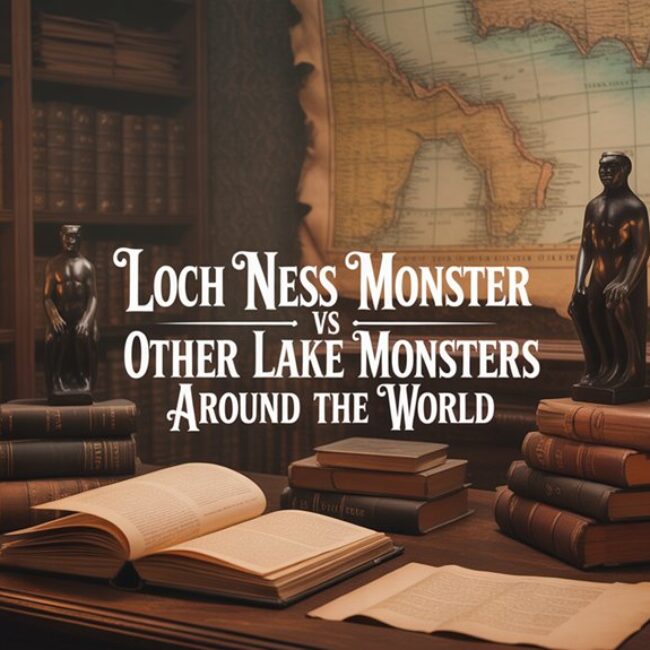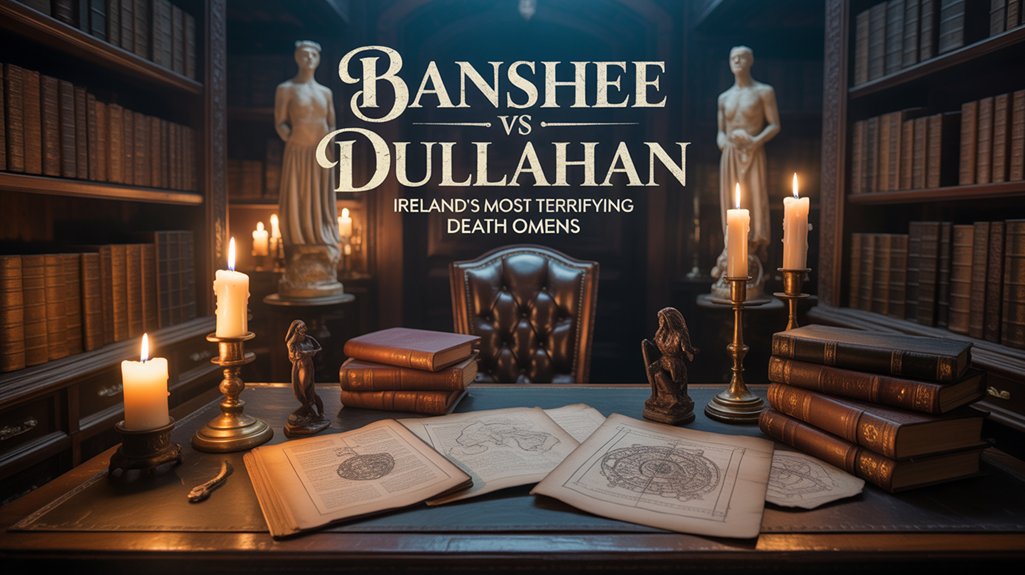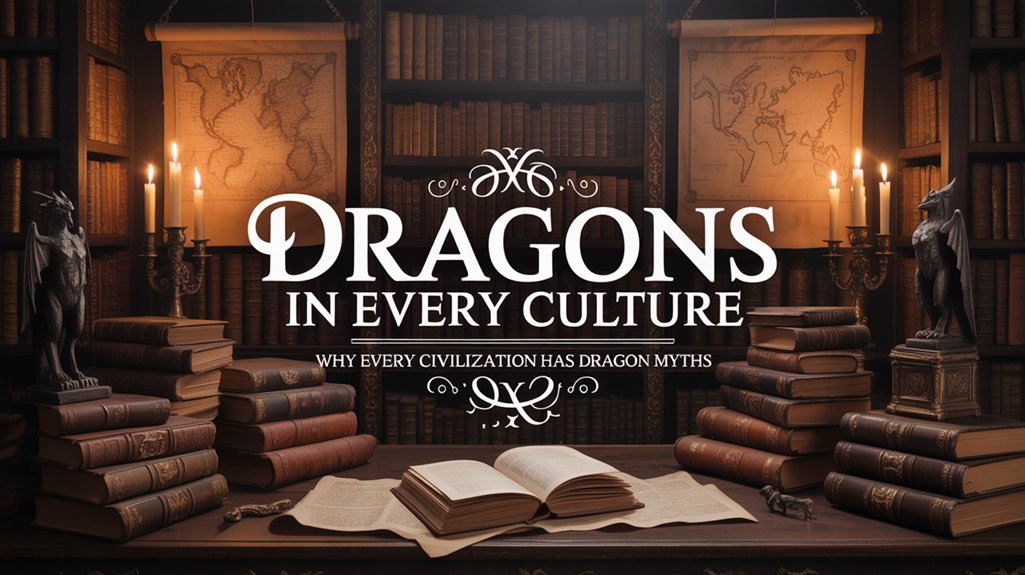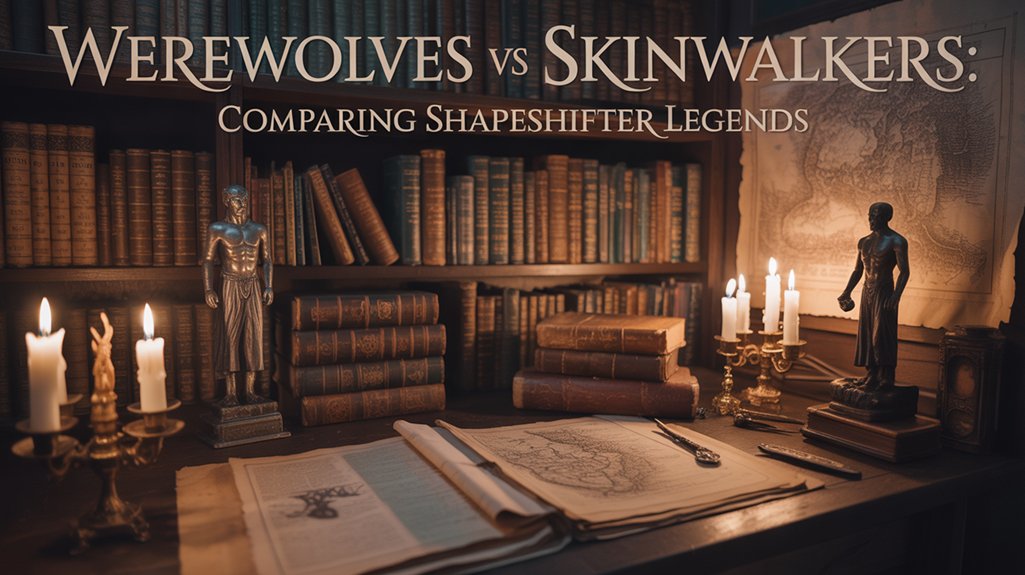You’ll witness the same primordial archetype manifesting across civilizations: China’s benevolent lung commanding rainfall with jade-shimmering scales, Norse Jormungandr encircling Midgard as world-serpent, Mesoamerica’s feathered Quetzalcoatl transcending earth and sky, Aboriginal Rainbow Serpents carving sacred waterways, Hindu Vritra hoarding life-giving waters, and Korean Yong legitimizing royal dynasties. Each culture carved this universal dragon into distinct flesh—weather-bringer, apocalyptic nemesis, agricultural teacher, or chaos embodiment. These chimeric beings reveal humanity’s shared unconscious, yet their varied forms unveil deeper mysteries awaiting discovery.
Table of Contents
ToggleKey Takeaways
- Chinese dragons represent benevolent cosmic forces controlling weather and imperial authority, contrasting sharply with European dragons as evil treasure guardians.
- Mesoamerican serpents like Quetzalcoatl symbolize transformative wisdom and divine rulership, teaching agriculture and calendar-making rather than hoarding wealth.
- Aboriginal Rainbow Serpents govern sacred waterways and seasonal cycles, maintaining ecological balance through ceremonial reciprocity with human communities.
- Norse Jormungandr embodies cosmic boundaries and apocalyptic fate, encircling the world as both containment force and agent of universal destruction.
- Slavic Zmey displays moral ambiguity with three heads representing temporal complexity, offering magical aid while inspiring fear and awe.
The Celestial Dragons of Ancient China: Wisdom and Weather Control
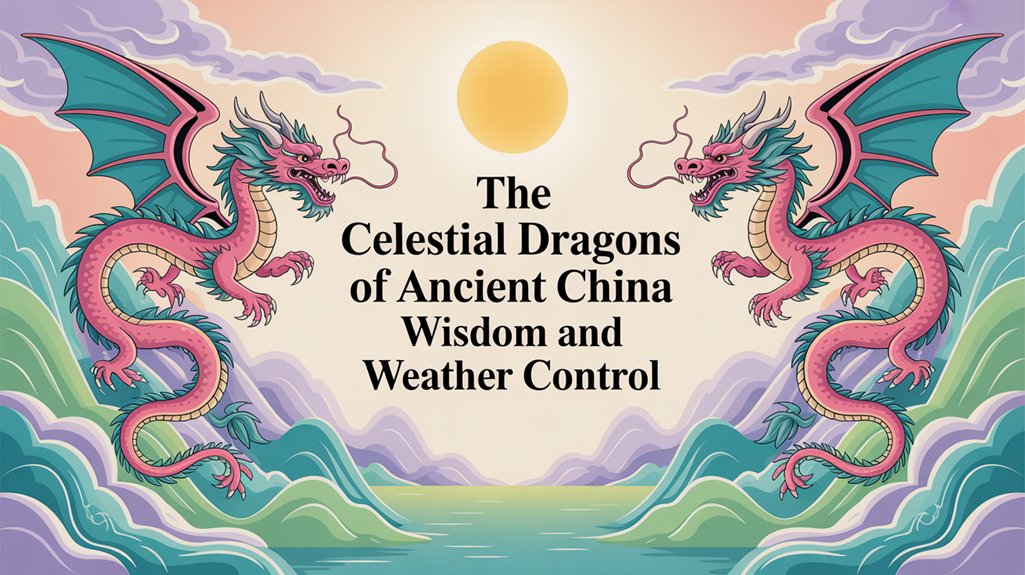
How could mortals comprehend the celestial magnificence that coiled through China’s earliest cosmological visions, breathing life into storm clouds and weaving wisdom through the fabric of imperial destiny? You’re witnessing the birth of *long*, those eldritch serpentine beings who transcended mere mythology to become living forces of nature itself.
These weren’t the fire-breathing destroyers of Western imagination. China’s dragons embodied benevolent power—chimeric creatures with pearl-crowned heads, antler-like horns, and scales that shimmered like liquid jade. They commanded rainfall for drought-stricken fields, their breath forming the mists that nurtured rice paddies across ancient kingdoms.
Benevolent chimeric beings with pearl-crowned majesty, commanding celestial rains to breathe life into ancient kingdoms through jade-shimmered scales.
By the Han Dynasty (206 BCE–220 CE), imperial courts recognized four distinct types: celestial dragons guarding heavenly palaces, spiritual dragons controlling wind and rain, earth dragons directing waterways, and treasure-guarding dragons protecting hidden wealth.
You’ll find their essence in every brushstroke of classical Chinese art, their wisdom embedded in Confucian texts. These beings didn’t merely inhabit Chinese consciousness—they shaped it, becoming eternal symbols of cosmic harmony and imperial authority. The rich tapestry of Chinese mythology includes thousands of such divine beings, from dragons to countless other gods and spirits that have guided the Middle Kingdom through millennia.
European Fire-Breathers: From Treasure Guardians to Christian Symbols
Where celestial benevolence ruled the East, Europe’s dragons emerged from primordial darkness as incarnations of primal chaos—serpentine behemoths whose very existence challenged the ordered world of mortals.
You’ll find these eldritich creatures evolved through distinct phases across millennia. Initially, they served as primordial guardians of earth’s hidden treasures—gold-hoarding wyrms dwelling in barrows and mountain caves. Norse sagas speak of Fafnir, the chimeric dwarf-turned-dragon whose avarice transformed flesh into scales. Germanic tribes whispered of lindworms coiled around ancient hoards.
Christianity’s ascendance transformed dragon symbolism entirely. No longer mere treasure guardians, they became Satan’s earthly manifestations. Ancient Greek mythology also featured serpentine monsters among its bestiary of fabulous creatures that terrorized heroes and challenged divine order.
- Beowulf’s fire-drake (8th century): The archetypal treasure-guardian whose death brings kingdom’s doom
- Saint George’s dragon (11th century): Evil incarnate defeated by Christian virtue
- Revelation’s scarlet beast: Seven-headed apocalyptic terror representing ultimate corruption
Medieval bestiaries codified these creatures as symbols of spiritual warfare—breathing sulfurous flames that scorched both flesh and soul, demanding heroes willing to sacrifice everything for freedom from their tyrannical dominion.
Norse Jormungandr: The World Serpent of Ragnarok
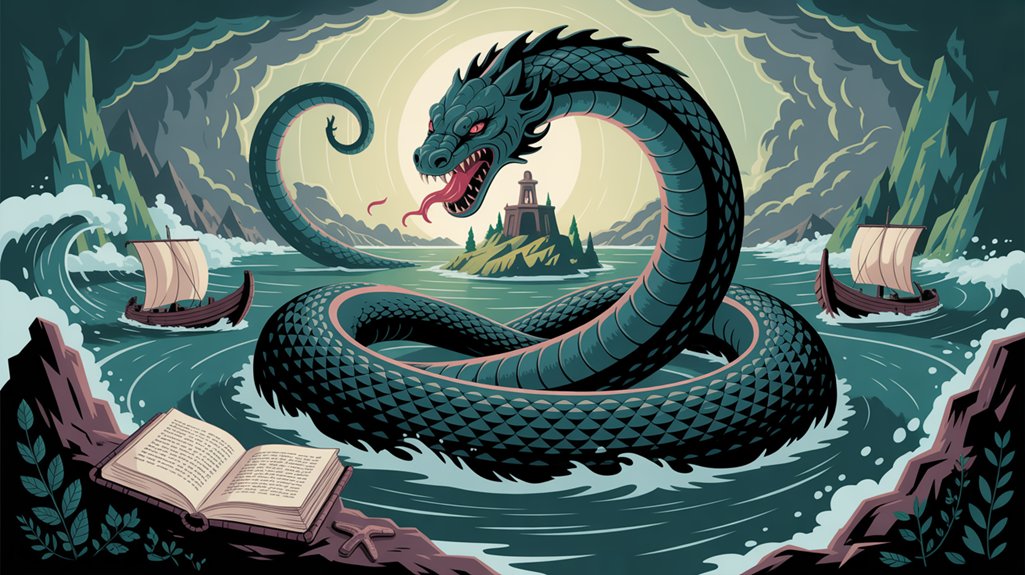
You’ll encounter Norse mythology’s most eldritch manifestation of draconic terror in Jormungandr, the World Serpent whose serpentine form encircles Midgard itself, tail clasped in its own maw—an ouroboros of apocalyptic proportions.
This chimeric leviathan exists as Thor’s ordained nemesis, their mutual destruction prophesied in the cosmic theater of Ragnarok, where thunder-god and world-serpent will achieve pyrrhic victory through reciprocal annihilation.
When Jormungandr rises from the primordial depths, thrashing against the nine realms’ foundations, you’re witnessing not mere destruction but the poison-breath herald of universal dissolution—venom so potent it’ll corrupt the very air that sustains creation.
Midgard’s Encircling Serpent
When does a serpent transcend its earthly form to become something far more eldritch—a cosmic force that binds the very fabric of existence? You’ll find your answer in Jormungandr, whose massive coils encircle Midgard like primordial shackles. This isn’t merely a creature—it’s a living boundary between order and chaos, its flesh forming the world’s perimeter.
The World Serpent’s immensity defies comprehension:
- Its body stretches completely around Earth, tail grasping its own mouth in eternal ouroboros
- Venom drips from fangs that could pierce mountains, creating poisonous seas
- Every movement generates earthquakes that shake the nine realms
Jormungandr represents containment and constraint—the ultimate prison guard of mortal existence. Yet this cosmic serpent also embodies inevitable liberation through destruction. When Ragnarok arrives, you’ll witness freedom’s price: the serpent’s release means reality’s end.
Thor’s Destined Enemy
No mortal conflict burns more fiercely in Norse cosmology than the predestined war between Thor and Jormungandr—a hatred so profound it transcends individual existence to become mythic inevitability. You witness thunder-god and world serpent locked in eldritch opposition, their enmity woven into reality’s fabric itself.
Their destined encounter at Ragnarök represents more than divine combat. Cosmic necessity. Thunder crashes against primordial chaos, order battling entropy in its most fundamental form. Thor’s hammer Mjolnir becomes civilization’s last bulwark against the chimeric forces that would unmake creation.
Yet this isn’t mere heroic triumph—you’ll find mutual destruction encoded in prophecy. Thor slays Jormungandr but succumbs to its venom nine steps later. Neither survives their confrontation. The very act of preserving order demands the guardian’s sacrifice, transforming victory into apocalyptic pyrrhic defeat.
Ragnarok’s Poisonous Doom
How does venom become the ultimate arbiter of cosmic fate? You witness in Jormungandr the Norse embodiment of apocalyptic inevitability, where poison transcends mere mortality to orchestrate universal dissolution. This eldritch serpent, coiled around Midgard’s foundations since primordial times, carries within its fangs the very essence of ending—not death alone, but the systematic unraveling of reality’s fabric.
When Ragnarok arrives, you’ll observe how Jormungandr’s venom operates beyond conventional toxicity:
- Atmospheric corruption – poisonous breath blackens skies, choking gods and mortals alike
- Mutual annihilation – Thor’s hammer crushes the serpent, yet venom claims the thunder god nine steps later
- Cosmic reset mechanism – toxic deluge prepares the world for rebirth through complete purification
This chimeric destroyer embodies freedom’s ultimate paradox: liberation through absolute destruction, where venom becomes the sacred catalyst transforming one cosmic cycle into another.
Quetzalcoatl: The Feathered Serpent of Mesoamerica
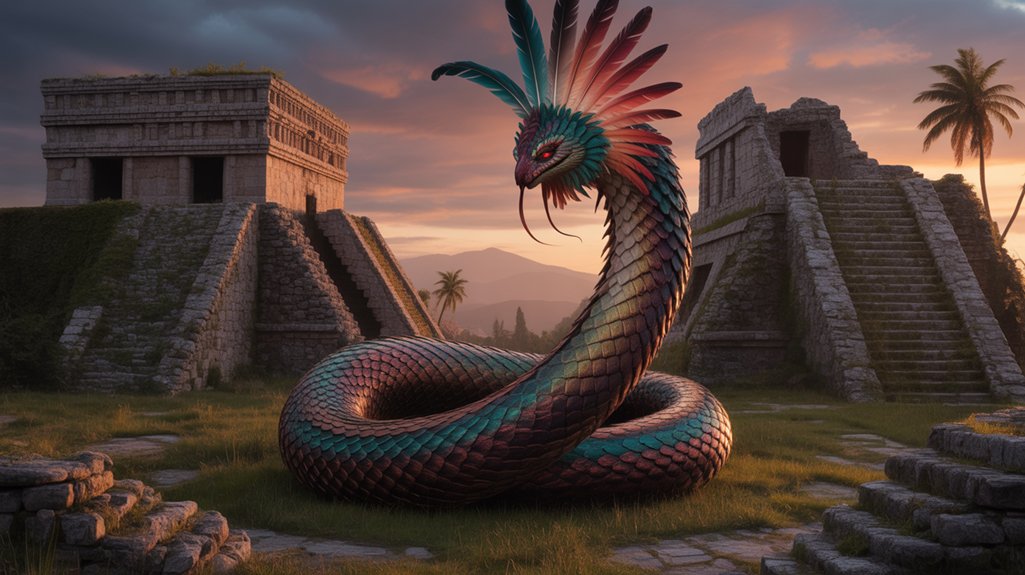
Across the jade-carved temples of ancient Mesoamerica, where obsidian pyramids pierced morning mists and copal incense spiraled toward star-mapped heavens, the Feathered Serpent emerged as perhaps the most enigmatic of all draconic entities—neither purely terrestrial nor wholly celestial, but something far more chimeric. You’ll find Quetzalcoatl transcending conventional dragon mythology, embodying wind, wisdom, and creation itself. Unlike Europe’s gold-hoarding wyrms or Asia’s storm-bringing lungs, this plumed deity governed knowledge and agricultural abundance.
From Teotihuacan’s Temple of the Feathered Serpent to Chichen Itza’s descending shadow-serpent, archaeological evidence reveals Quetzalcoatl’s enduring power across centuries. The Aztecs revered Ce Acatl Topiltzin Quetzalcoatl as both divine archetype and historical ruler. Turquoise mosaics depicted serpentine forms crowned with quetzal plumes—sacred fusion of earth’s cunning and sky’s freedom.
This wasn’t destruction incarnate. This was transformation itself, teaching humanity agriculture, calendar-making, and self-sacrifice. Pure draconic wisdom without malevolence.
Rainbow Serpents: Aboriginal Australian Creation Spirits
You’ll encounter the Rainbow Serpent threading through Aboriginal Australian consciousness like an eldritch current, its serpentine form weaving creation itself from the primordial waters of the Dreamtime—that eternal, sacred epoch when ancestral spirits shaped the continent’s rivers, billabongs, and life-giving arteries.
These chimeric beings don’t merely guard waterways; they’re the waterways, their undulating bodies carving sacred geography across the red earth while their seasonal movements bring the monsoons that metamorphose desert into Eden.
The Rainbow Serpent’s covenant with humanity pulses through forty thousand years of unbroken tradition, making it perhaps Earth’s oldest continuous dragon archetype.
Sacred Waterway Guardians
When did the serpentine architects of creation first paint their scales across the Australian sky, weaving rivers from their undulating bodies and breathing life into the red earth below? You’ll discover these Rainbow Serpents aren’t mere mythological constructs—they’re living custodians of sacred waterways, their chimeric forms threading through forty thousand years of Aboriginal cosmology. These eldritcht beings carved the Murray-Darling system with deliberate precision, transforming barren landscapes into fertile sanctuaries.
Their protective dominion encompasses:
- Billabongs and sacred springs where initiation ceremonies unfold beneath starlit skies
- Seasonal flooding patterns that mirror ancient dreaming tracks across the continent
- Ancestral law codes governing water access, land stewardship, and tribal boundaries
You’re witnessing guardianship that transcends Western conservation concepts. These serpentine deities demand reciprocity—honoring their waters through ceremony, song, and respectful harvest practices.
Dreamtime Origin Stories
Every creation begins in the Dreamtime—that primordial epoch where ancestral beings stirred from eternal slumber to sculpt reality itself.
You’ll discover the Rainbow Serpent threading through Aboriginal Australian consciousness, an eldritch entity whose chimeric form bridges water, sky, and earth. These serpentine creators carved riverbeds with their undulating bodies, their scales shimmering with opalescent hues that birthed the aurora australis.
The Waugyl of southwestern Australia, the Yurlunggur of Arnhem Land—each manifestation carries distinct tribal signatures yet shares fundamental attributes. Sacred waterholes mark where these beings descended, their presence still palpable in ochre-stained rock art spanning sixty thousand years. You’re witnessing humanity’s oldest continuous mythological tradition, where serpentine dragons don’t merely exist in stories but remain active participants in contemporary Aboriginal spiritual practice, their Dreamtime essence forever weaving through the fabric of existence.
Seasonal Rain Bringers
Beyond their cosmogonic role as world-shapers, these primordial serpents command the meteorological forces that sustain life across the continent’s vast expanses. You’ll witness the Rainbow Serpent’s eldritch mastery over precipitation cycles, its chimeric form manifesting as thunder clouds pregnant with life-giving water. When monsoon seasons arrive, Aboriginal communities recognize the serpent’s deliberate awakening from subterranean slumber.
- Wet season heralds: These beings emerge from sacred billabongs, their scales glistening with accumulated moisture
- Drought arbiters: Their withdrawal into earth’s depths signals the harsh dry months ahead
- Lightning conductors: Electric discharge follows their skyward movement, announcing imminent rainfall
The serpent’s meteorological authority transcends mere weather control—it represents the sacred covenant between spiritual forces and terrestrial survival, binding human communities to cosmic rhythms through reverent acknowledgment of serpentine sovereignty.
Nagas of South and Southeast Asia: Divine Water Guardians
How does the serpentine form transcend mere earthly existence to embody cosmic principles themselves? You’ll find your answer in the nagas of South and Southeast Asia, where serpent-deities coil through millennia of sacred tradition. These chimeric beings—part cobra, part human—govern rivers, lakes, and underground waters with divine authority that predates the Buddha himself.
In Sanskrit texts dating to 1500 BCE, nagas emerge as primordial guardians. Eldritch wisdom flows through their scaled forms. You witness their transformation from feared water-spirits into Buddhist protectors, their hoods sheltering meditation masters from storms. Temple carvings across Angkor Wat reveal their cosmic significance—seven-headed Mucalinda defending enlightenment itself.
Their dominion extends beyond mere moisture. Underground palaces. Treasure hoards. The very foundations of reality. In Thai mythology, naga princesses marry mortal kings, birthing royal bloodlines. Cambodia’s Mekong still whispers their names. These aren’t simple rain-bringers—they’re cosmic architects weaving consciousness through water’s endless cycle.
Japanese Ryu: Benevolent Sea and Sky Dwellers
Where the naga’s coiled wisdom flows through earthbound waters, Japan’s ryu ascend to celestial heights as benevolent masters of both sea and sky. You’ll discover these eldritch beings emerged from ancient Chinese lung mythology, yet evolved into distinctly Japanese entities during the Heian period (794-1185). Unlike their Western counterparts, ryu embody divine benevolence, wielding storms not as weapons but as life-giving forces.
These chimeric guardians possess serpentine bodies adorned with antler-crowned heads, their scales shimmering between azure depths and pearl-white clouds. You’re witnessing creatures that bridge realms—dwelling in underwater palaces while commanding thunder and rain from celestial domains.
- Ryujin’s oceanic kingdom: The sea god’s coral palace houses magical tide-jewels controlling ocean currents
- Weather manipulation: Ryu summon beneficial rains during droughts, their roars becoming thunder
- Imperial symbolism: Japanese emperors claimed ryu lineage, legitimizing divine authority through draconic heritage
Their presence transforms natural phenomena into sacred theater, where typhoons become divine choreography and rainfall represents celestial blessing.
Slavic Zmey: Three-Headed Terror and Unexpected Ally
Why does terror so often mask profound wisdom in Slavic mythology? You’ll find the answer writhing within the zmey’s chimeric form, where three serpentine heads breathe eldritch fire across Eastern European landscapes. These draconic entities emerged from pre-Christian Slavic consciousness around the 6th century CE, embodying the paradox of destruction and protection that defines the human condition.
Terror incarnate. The zmey devours villages, hoards golden treasures in underground lairs, and kidnaps princesses with calculated malevolentence. Yet scratch beneath those obsidian scales, and you’ll discover unexpected depths. These beings frequently aid heroes, offering magical assistance to those who demonstrate courage, wisdom, or proper respect for ancient protocols.
The zmey’s triple-headed nature reflects Slavic understanding of temporal complexity—past, present, future converging in one terrible, magnificent form. Unlike their Western counterparts, these dragons navigate moral ambiguity with fluid grace, teaching you that wisdom often wears frightening masks to test your worthiness.
Celtic Wyrms: Earth-Bound Serpents of the British Isles
When did the serpentine pulse of primordial Britain first coil through stone circles and sacred groves? You’ll find Celtic wyrms weren’t sky-dancers like their Eastern cousins, but earth-bound guardians dwelling in barrows, caves, and the liminal spaces between worlds. These eldritch serpents embodied the land’s raw power—neither benevolent nor malevolent, but utterly wild.
Ancient wyrms coiled through Britain’s sacred stones—not celestial dancers, but primordial earth-guardians dwelling in barrows and threshold spaces, embodying the land’s untamed essence.
The Celts understood dragons as manifestations of telluric force. Ancient. Untamed. You’d encounter them guarding sacred wells or treasure hoards, their forms chimeric blends of serpent and earth-spirit.
- Territorial Guardians: Wyrms claimed specific locations—burial mounds, sacred springs, or iron-age hillforts
- Seasonal Awakening: These creatures stirred during Samhain and Beltane, when veils thinned between realms
- Prophetic Powers: Celtic dragons possessed oracular abilities, their dreams shaping the land’s destiny
Unlike Christian retellings that demonized them, pre-Roman Celts revered these beings as necessary forces maintaining cosmic balance between civilization and wilderness.
Persian Azhdaha: Ancient Enemy of Light and Order
Far from the verdant hills where Celtic wyrms slumbered beneath ancient stones, the blazing steppes of Persia birthed creatures of pure malevolence—the azhdaha, primordial serpents whose very existence challenged the cosmic order of Ahura Mazda.
You’ll discover these eldritch beings in the Avesta, Zoroastrianism’s sacred texts from the 6th century BCE, where they emerge as chaos incarnate. Unlike their European counterparts, azhdaha embody absolute spiritual corruption—serpentine titans with multiple heads, breathing poison rather than flame, dwelling in underground realms of perpetual darkness.
The legendary Zahhak represents their chimeric evolution: a human king transformed into a three-headed dragon through Ahriman’s corruption, ruling a thousand-year reign of terror until Fereydun’s liberation.
These weren’t mere monsters but theological constructs representing entropy itself. Ancient Persians understood azhdaha as necessary opposition—darkness defining light, chaos giving meaning to divine order. They’re freedom’s antithesis, yet paradoxically essential to cosmic balance.
Egyptian Apep: Chaos Serpent of the Underworld
You’ll encounter in Egypt’s primordial mythology the eldritch serpent Apep, whose colossal form embodies the antithesis of cosmic order—a writhing manifestation of chaos that dwells in the shadowed depths of Duat, the underworld realm where darkness reigns eternal.
Each night, as Ra’s solar barque traverses the perilous waters of the afterlife, you witness the cyclical confrontation between divine light and primordial entropy, where the sun god’s luminous ka battles against Apep’s suffocating coils that threaten to devour all creation.
This serpentine adversary represents far more than mere mythological antagonist; it’s the very essence of dissolution, the force that seeks to return the ordered cosmos to its pre-creation state of undifferentiated void.
Nightly Battle Against Ra
Ancient Egyptian scribes trembled as they chronicled the eternal warfare between light and primordial darkness, their hieroglyphic accounts detailing how Apep—the colossal serpent of chaos—wages nightly battle against Ra’s solar barque as it traverses the treacherous Duat underworld. You’ll witness this cosmic struggle unfold in cyclical terror, where victory remains perpetually uncertain.
Each dusk brings renewed conflict:
- The Serpent’s Ambush: Apep coils within shadowed caverns, his eldritch bulk stretching miles beneath starless waters
- Divine Defenders: Set and other deities stand ready with spears, their weapons blazing with protective incantations
- The Swallowing Threat: Should Apep succeed, eternal night would consume existence itself
This primordial dragon embodies humanity’s deepest fears—that darkness might triumph, that order could collapse. You’re observing mythology’s most fundamental terror: the fragility of light against chaos’s hungry maw.
Serpentine Symbol of Disorder
What darker symbolism could manifest than that of Apep, whose serpentine form embodies the very antithesis of creation itself? You encounter here the primordial chaos serpent, whose eldritch essence threatens to unravel Ma’at’s cosmic order. This chimeric entity dwells within the underworld’s darkest recesses, eternally opposing divine harmony through its mere existence.
| Aspect | Symbolic Meaning | Cultural Impact |
|---|---|---|
| Serpentine Form | Primordial chaos | Divine opposition |
| Underworld Dwelling | Hidden destruction | Cosmic threat |
| Eternal Nature | Unending disorder | Cyclical struggle |
| Darkness Association | Absence of light | Negation of creation |
You’re witnessing humanity’s attempt to comprehend entropy itself. Apep represents those forces that seek dissolution, the unmaking of structured reality. Through this ancient Egyptian lens, chaos isn’t merely disorder—it’s active opposition to existence’s fundamental principles.
Hindu Vritra: The Drought Demon Dragon
Deep within the Rigveda’s most ancient hymns, composed between 1500 and 1200 BCE, lies the primordial tale of Vritra—the serpentine demon whose very name means “encloser” or “coverer.” This eldritch entity didn’t merely breathe fire or hoard gold like his Western counterparts; instead, he wielded drought as his weapon, coiling his massive form around the world’s waters and imprisoning them within mountain fortresses of stone and shadow.
You’ll discover Vritra represents humanity’s deepest terror: the withholding of life’s essence. His serpentine coils strangled rivers, lakes, and monsoon clouds, transforming fertile valleys into wastelands where crops withered and children starved.
- Cosmic imprisonment: Vritra’s body formed primordial barriers between order and chaos
- Atmospheric dominion: He controlled weather patterns through draconic manipulation of water cycles
- Sacrificial defeat: Only through Indra’s thunderbolt—forged from sage Dadhyanc’s bones—could liberation flow
This ancient dragon embodies environmental catastrophe personified, drought given chimeric form.
Korean Yong: Royal Symbols of Power and Protection
While Vritra embodied the catastrophic withholding of water’s life force, Korea’s Yong dragons emerged from entirely different primordial waters—celestial seas where benevolent serpents metamorphosed into sovereign protectors of earthly kingdoms.
From celestial waters, Korea’s Yong dragons transformed from primordial serpents into benevolent guardians of royal dynasties and earthly realms.
You’ll discover these eldritch beings adorning Joseon Dynasty palaces, their sinuous forms carved into throne halls where kings claimed divine mandate. Unlike their destructive counterparts, Yong possessed four legs, antlered crowns, and pearl-clutching talons that channeled cosmic authority into mortal rule. They’re chimeric amalgamations of turtle shells, fish scales, and serpentine grace—living embodiments of Korea’s Confucian hierarchies made manifest.
Royal robes blazed with five-clawed Yong, their golden threads weaving protection around vulnerable monarchs. Rain magic. Agricultural abundance. Military victory. These dragons didn’t hoard treasure; they became it, transforming into regalia that legitimized power through supernatural endorsement.
Ancient shamans understood: to wear the Yong was to channel heaven’s approval, bridging the liminal space between earthly governance and celestial order.
African Python Spirits: Ancestral Wisdom Keepers
How do the serpentine coils of ancient knowledge manifest when python spirits emerge from Africa’s primordial consciousness, carrying ancestral wisdom through generations of reverent communion? You’ll discover these eldritch guardians dwelling within the sacred groves of West and Central Africa, where Yoruba traditions honor Oshunmare—the rainbow serpent bridging earthly and celestial realms. Unlike their chimeric Asian counterparts, African python spirits embody pure ancestral authority, their massive forms coiling through dreamscapes and ritual spaces.
The Fon people of Benin revere Dan, the cosmic python whose undulating body creates mountains and rivers. Sacred communion occurs through possession rituals, where initiated priests channel serpentine wisdom.
- Damballah Wedo in Haitian Vodou represents primordial creation force
- Mamlambo among Zulu peoples guards river crossings and fertility
- Aido-Hwedo supports the earth itself, preventing cosmic collapse
These aren’t mere symbols—they’re living repositories of collective memory. You’re witnessing ancient African consciousness preserving itself through serpentine vessels.
Modern Interpretations: How Ancient Dragons Evolved in Contemporary Culture
Where once the ancient wyrms coiled through temple incense and ritual fires, today’s dragons breathe through fiber optic cables and digital realms, their metamorphosis from sacred guardian to pop culture phenomenon revealing humanity’s persistent need for transcendent power.
You witness this chimeric evolution across mediums where eldritch wisdom transforms into entertainment. Gaming universes resurrect dragons as boss battles and companions, their primal authority diluted yet persistent. Fantasy literature channels ancient serpent-kings into narrative vessels, while cinema renders digital leviathans that echo primordial fears.
| Medium | Ancient Element | Modern Expression |
|---|---|---|
| Gaming | Guardian Spirit | Rideable Mount/Boss |
| Literature | Wisdom Keeper | Mentor/Antagonist |
| Cinema | Weather Controller | CGI Spectacle |
Yet beneath Hollywood’s veneer, you’ll find authentic threads—the protective Chinese long persisting in martial arts films, Nordic wyrms haunting Scandinavian metal, African serpent-spirits emerging through Afrofuturism. These contemporary dragons retain their ancestral DNA while adapting to humanity’s evolving consciousness, proving that some archetypes transcend temporal boundaries.
Frequently Asked Questions
Why Do Dragons Appear in Cultures With No Historical Contact?
You’re witnessing humanity’s deepest archetypal memories manifesting across isolated civilizations. These serpentine leviathans emerge from shared primordial fears—ancient encounters with massive predators, serpents, crocodilians that once threatened our ancestors.
The dragon’s chimeric form reflects universal anxieties about untamed nature’s power. Jung’s collective unconscious explains this phenomenon: you’re accessing inherited psychological patterns, eldritch memories encoded in human DNA, transcending geographical boundaries to birth identical mythic creatures worldwide.
What Psychological Factors Make Dragon Myths Universal Across Human Societies?
Like shadows cast by your own psyche’s primordial fires, dragons emerge from humanity’s collective unconscious—that eldritch repository Jung mapped. You’re hardwired to fear serpentine predators, yet yearn for transcendent power. These chimeric beasts embody your deepest terrors: chaos, death, the unknown abyss. Simultaneously, they represent what you desperately seek—wisdom, metamorphosis, dominion over natural forces. Dragons manifest because you need them. They’re psychological mirrors reflecting your eternal struggle between civilization and wildness.
How Do Modern Dragon Depictions Compare to Their Ancient Origins?
You’ll find modern dragons stripped of their primordial terror, transformed from eldritch harbingers of cosmic chaos into domesticated companions. Ancient wyrms embodied untamed natural forces—storm-bringers, earth-shakers, boundary-guardians between mortal and divine realms. Today’s iterations lack that numinous dread. Where Mesopotamian Tiamat represented primeval waters’ destructive power, contemporary dragons serve as fantasy pets or noble allies. The chimeric essence remains, but civilization’s sanitized these creatures, severing their connection to humanity’s deepest fears.
Are There Any Cultures That Completely Lack Dragon-Like Mythological Creatures?
You’ll find virtually no cultures entirely devoid of serpentine, chimeric entities—the dragon archetype transcends geographic boundaries with eldritch persistence. Even isolated Pacific islanders conjured rainbow serpents; Arctic peoples whispered of ice-wyrms. Australia’s Aboriginal dreamtime births the Rainbow Serpent. These primordial forms manifest across every continent, suggesting humanity’s collective unconscious harbors this archetypal beast. The dragon’s absence represents true rarity; its presence, near-universal testimony to shared mythological DNA coursing through civilization’s veins.
What Real Animals Might Have Inspired Early Dragon Mythologies?
You’ll discover that ancient serpents, crocodiles, and massive pythons likely seeded these eldritch visions. Fossilized dinosaur bones emerging from eroded cliffs whispered of chimeric beasts to early peoples. Monitor lizards, with their forked tongues and predatory grace, embodied draconic essence. You can’t ignore how soaring eagles and hawks contributed wings to these mythic amalgamations. Lightning’s serpentine flash across storm-darkened skies completed the archetype, fusing earthbound reptilian terror with celestial power in humanity’s collective unconscious.
Conclusion
You’ve journeyed through the labyrinthine corridors of draconic mythology, witnessing how humanity’s collective unconscious births the same chimeric archetype across continents. Whether you encounter China’s celestial wisdom-bearers or Australia’s rainbow creators, you’re gazing upon fragments of one primordial mirror. These eldritch beings aren’t mere folklore—they’re psychological blueprints, revealing our deepest fears and aspirations. In our digital age, you’ll find these ancient serpents still coiling through modern consciousness, eternally undaunted.


